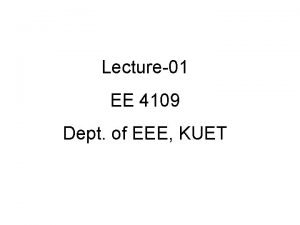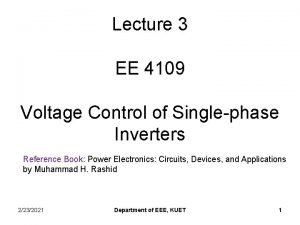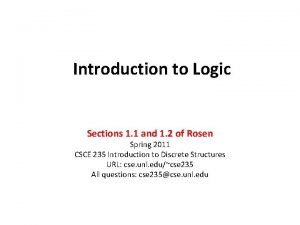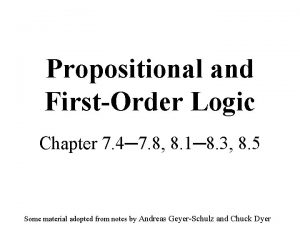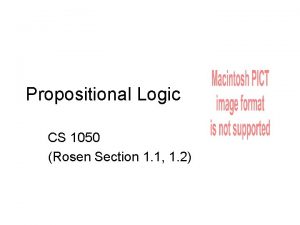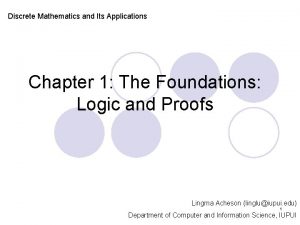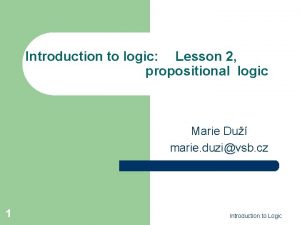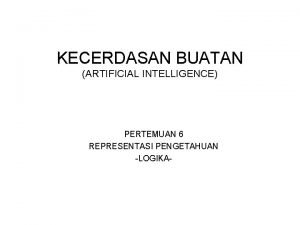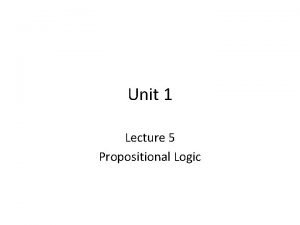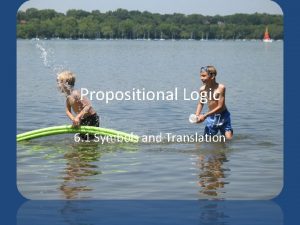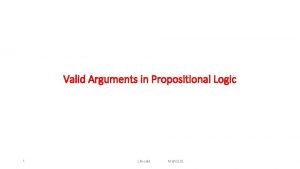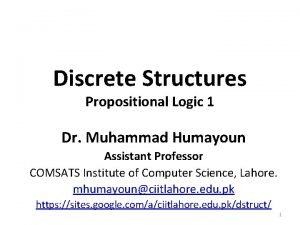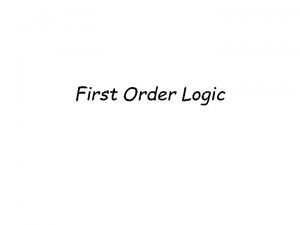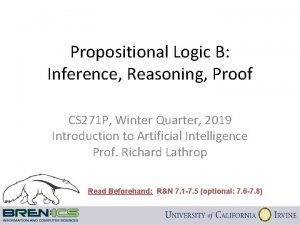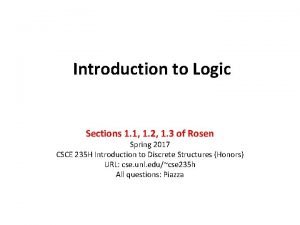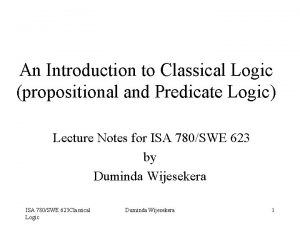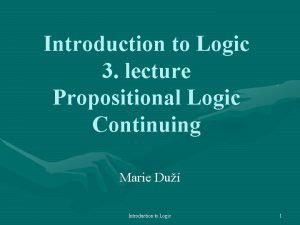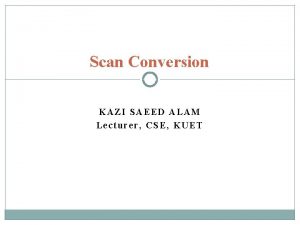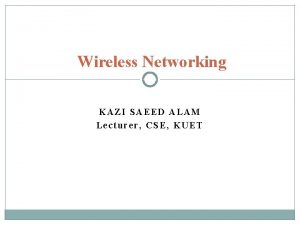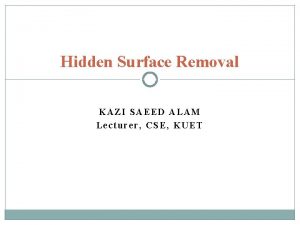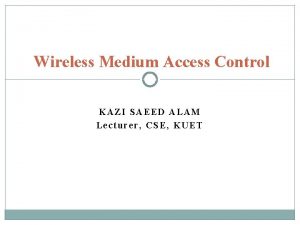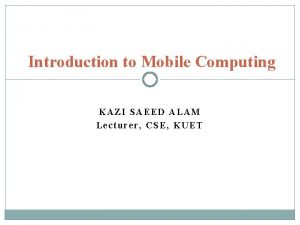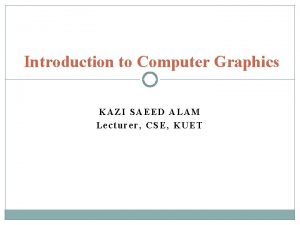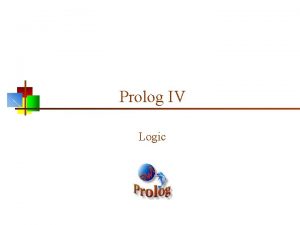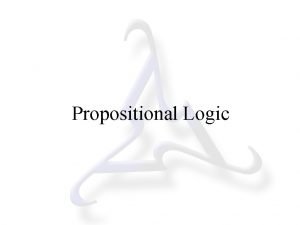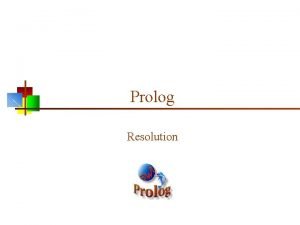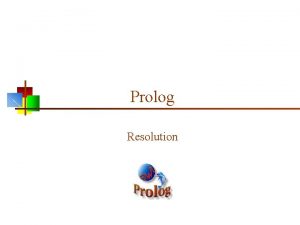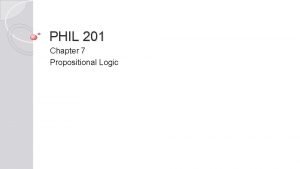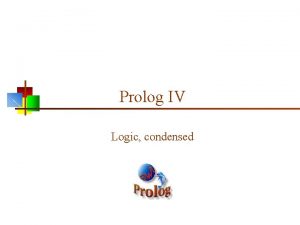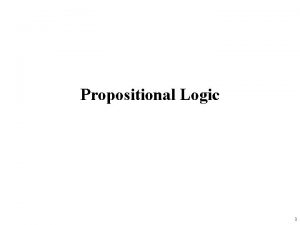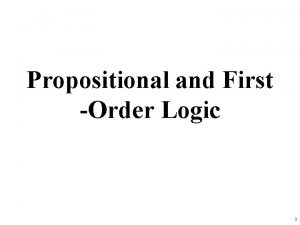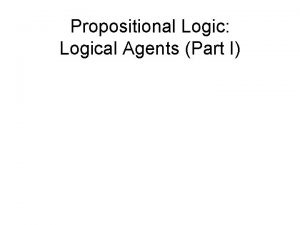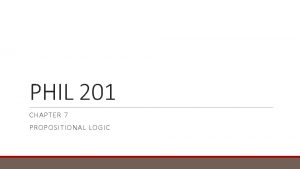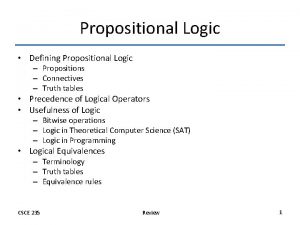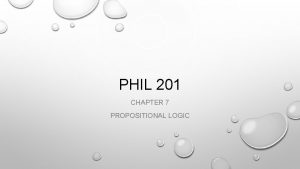Propositional Logic Kazi Saeed Alam Lecturer CSE KUET




![Wumpus World Example Environment Cave of 4× 4 Agent enters in [1, 1] 16 Wumpus World Example Environment Cave of 4× 4 Agent enters in [1, 1] 16](https://slidetodoc.com/presentation_image_h/002e4064871fad821b907aecf92aeab4/image-5.jpg)



![Exploring the Wumpus World [1, 1] The KB initially contains the rules of the Exploring the Wumpus World [1, 1] The KB initially contains the rules of the](https://slidetodoc.com/presentation_image_h/002e4064871fad821b907aecf92aeab4/image-9.jpg)
![Exploring the Wumpus World [2, 1] = breeze indicates that there is a pit Exploring the Wumpus World [2, 1] = breeze indicates that there is a pit](https://slidetodoc.com/presentation_image_h/002e4064871fad821b907aecf92aeab4/image-10.jpg)
![Exploring the Wumpus World [1, 2] Stench in cell which means that wumpus is Exploring the Wumpus World [1, 2] Stench in cell which means that wumpus is](https://slidetodoc.com/presentation_image_h/002e4064871fad821b907aecf92aeab4/image-11.jpg)
![Exploring the Wumpus World THUS … wumpus is in [1, 3] THUS [2, 2] Exploring the Wumpus World THUS … wumpus is in [1, 3] THUS [2, 2]](https://slidetodoc.com/presentation_image_h/002e4064871fad821b907aecf92aeab4/image-12.jpg)
![Exploring the Wumpus World [2, 2] move to [2, 3] detect glitter , smell, Exploring the Wumpus World [2, 2] move to [2, 3] detect glitter , smell,](https://slidetodoc.com/presentation_image_h/002e4064871fad821b907aecf92aeab4/image-13.jpg)








- Slides: 21

Propositional Logic Kazi Saeed Alam Lecturer, CSE, KUET

Propositional logic: Methods of proofs • Truth table enumeration Check the truth value of statement for all interpretations • Application of inference rules Derive new sentences which are logical consequences of s 1, s 2, …, sn using only syntactic operations.

Propositional logic: Inference Rules

Propositional logic: Inference Rules
![Wumpus World Example Environment Cave of 4 4 Agent enters in 1 1 16 Wumpus World Example Environment Cave of 4× 4 Agent enters in [1, 1] 16](https://slidetodoc.com/presentation_image_h/002e4064871fad821b907aecf92aeab4/image-5.jpg)
Wumpus World Example Environment Cave of 4× 4 Agent enters in [1, 1] 16 rooms Wumpus: A deadly beast who kills anyone entering his room. Pits: Bottomless pits that will trap you forever. Gold

Wumpus World Example Agents Sensors: Stench next to Wumpus Breeze next to pit Glitter in square with gold Bump when agent moves into a wall Scream from wumpus when killed Agents actions Agent can move forward, turn left or turn right Shoot, one shot

Wumpus World Example Performance measure +1000 for picking up gold -1000 got falling into pit -1 for each move -10 for using arrow

Reasoning in the Wumpus World Agent has initial ignorance about the configuration Agent knows his/her initial location Agent knows the rules of the environment Goal is to explore environment, make inferences (reasoning) to try to find the gold. Random instantiations of this problem used to test agent reasoning and decision algorithms.
![Exploring the Wumpus World 1 1 The KB initially contains the rules of the Exploring the Wumpus World [1, 1] The KB initially contains the rules of the](https://slidetodoc.com/presentation_image_h/002e4064871fad821b907aecf92aeab4/image-9.jpg)
Exploring the Wumpus World [1, 1] The KB initially contains the rules of the environment. Nothing is percept. move to safe cell e. g. 2, 1
![Exploring the Wumpus World 2 1 breeze indicates that there is a pit Exploring the Wumpus World [2, 1] = breeze indicates that there is a pit](https://slidetodoc.com/presentation_image_h/002e4064871fad821b907aecf92aeab4/image-10.jpg)
Exploring the Wumpus World [2, 1] = breeze indicates that there is a pit in [2, 2] or [3, 1], return to [1, 1] to try next safe cell
![Exploring the Wumpus World 1 2 Stench in cell which means that wumpus is Exploring the Wumpus World [1, 2] Stench in cell which means that wumpus is](https://slidetodoc.com/presentation_image_h/002e4064871fad821b907aecf92aeab4/image-11.jpg)
Exploring the Wumpus World [1, 2] Stench in cell which means that wumpus is in [1, 3] or [2, 2] YET … not in [1, 1] YET … not in [2, 2] or stench would have been detected in [2, 1] (this is relatively sophisticated reasoning!)
![Exploring the Wumpus World THUS wumpus is in 1 3 THUS 2 2 Exploring the Wumpus World THUS … wumpus is in [1, 3] THUS [2, 2]](https://slidetodoc.com/presentation_image_h/002e4064871fad821b907aecf92aeab4/image-12.jpg)
Exploring the Wumpus World THUS … wumpus is in [1, 3] THUS [2, 2] is safe because of lack of breeze in [1, 2] THUS pit in [3, 1] (again a clever inference) move to next safe cell [2, 2]
![Exploring the Wumpus World 2 2 move to 2 3 detect glitter smell Exploring the Wumpus World [2, 2] move to [2, 3] detect glitter , smell,](https://slidetodoc.com/presentation_image_h/002e4064871fad821b907aecf92aeab4/image-13.jpg)
Exploring the Wumpus World [2, 2] move to [2, 3] detect glitter , smell, breeze THUS pick up gold THUS pit in [3, 3] or [2, 4]

What our example has shown us Can represent general knowledge about an environment by a set of rules and facts Can gather evidence and then infer new facts by combining evidence with the rules The conclusions are guaranteed to be correct if The evidence is correct The rules are correct The inference procedure is correct -> logical reasoning The inference may be quite complex E. g. , evidence at different times, combined with different rules, etc

Wumpus World Sentences Let Pi, j be true if there is a pit in [i, j]. Let Bi, j be true if there is a breeze in [i, j]. start: P 1, 1 B 1, 1 B 2, 1 "Pits cause breezes in adjacent squares" B 1, 1 (P 1, 2 P 2, 1) B 2, 1 (P 1, 1 P 2, 2 P 3, 1) KB can be expressed as the conjunction of all of these sentences Note that these sentences are rather long-winded! E. g. , breeze “rule” must be stated explicitly for each square First-order logic will allow us to define more general patterns.

Applying Inference Rules in Wumpus World • Goal : “Prove that, wumpus is in [1, 3]” • Atomic Propositional Variables for Wumpus World • Let Pi, j be true if there is a pit in [i, j]. • Let Bi, j be true if there is a breeze in [i, j]. • Let Wi, j be true if there is a wumpus in [i, j]. • Let Si, j be true if agent perceives stench in [i, j]. • Let Vi, j be true if square [i, j] is visited. • Let Gi, j be true if there is gold in [i, j]. • Let OKi, j be true if square [i, j] is safe.

Applying Inference Rules in Wumpus World • Rules • Rule 1: ¬S 1, 1 →(¬W 1, 1 ¬W 2, 1 ¬W 1, 2 ) • Rule 2: ¬S 2, 1 →(¬W 2, 1 ¬W 1, 1 ¬W 3, 1 ¬W 2, 2 ) • Rule 3: S 1, 2 →(W 1, 1 W 2, 2 W 1, 3 ) • We can apply inference rules to prove that wumpus is in [1, 3] • Applying Modus ponens to rule 1 (¬S 1, 1 is true ), we get (¬W 1, 1 ¬W 2, 1 ¬W 1, 2 ) is true……. (i) • Applying Modus ponens to rule 2 (¬S 2, 1 is true ), we get (¬W 2, 1 ¬W 1, 1 ¬W 3, 1 ¬W 2, 2 ) is true……. . (ii) • Applying Modus ponens to rule 3 (S 1, 2 is true ), we get (W 1, 1 W 2, 2 W 1, 3 ) is true………. (iii)

Applying Inference Rules in Wumpus World • Applying And-Elimination to (i) we get, ¬W 1, 1 , ¬W 2, 1 , ¬W 1, 2 are true……. (iv) • Applying And-Elimination to (ii) we get, ¬W 2, 1 , ¬W 1, 1 , ¬W 3, 1 , ¬W 2, 2 are true……. . (v) • Applying Unit Resolution to (iii) and (iv), we get (W 2, 2 W 1, 3 ) is true…………(vi) • Applying Unit Resolution to (vi) and (v), we get (W 1, 3 ) is true Hence, wumpus in [1, 3] proved!!!!!!!

Now try this! • “The person is a toddler; If the person is a toddler then the person is a child; If the person is a child and male then the person is a boy; If the person is an infant then the person is a child; If the person is a child and female then the person is a girl; The person is a female; ” • Express above sentences in propositional logic and prove that the person is a girl.

Limitations of Propositional logic • It is too weak, i. e. , has very limited expressiveness: Each rule has to be represented for each situation: e. g. , “don’t go forward if the wumpus is in front of you” takes 64 rules. • It cannot keep track of changes: If one needs to track changes, e. g. , where the agent has been before then we need a timed-version of each rule. To track 100 steps we’ll then need 6400 rules for the previous example. Its hard to write and maintain such a huge rule-base Inference becomes intractable

References • “Artificial Intelligence A Modern Approach” - Third Edition - Stuart J. Russell and Peter Norvig. • CHP-7
 Lecturer's name
Lecturer's name Kuet cse
Kuet cse First order logic vs propositional logic
First order logic vs propositional logic First order logic vs propositional logic
First order logic vs propositional logic First order logic vs propositional logic
First order logic vs propositional logic Kuet eee
Kuet eee Kuet angle
Kuet angle Idempotent law truth table
Idempotent law truth table Symbols used in logic
Symbols used in logic Xor in propositional logic
Xor in propositional logic Xor in propositional logic
Xor in propositional logic Contradiction formula
Contradiction formula Propotional logic dapat digunakan untuk
Propotional logic dapat digunakan untuk Examples of propositions
Examples of propositions Compound statement symbols
Compound statement symbols Arguments in logic
Arguments in logic Discrete math propositional logic
Discrete math propositional logic Biconditional proposition examples
Biconditional proposition examples Propositional logic notation
Propositional logic notation Logical connectives
Logical connectives Semantics of predicate logic
Semantics of predicate logic Contradiction formula
Contradiction formula





